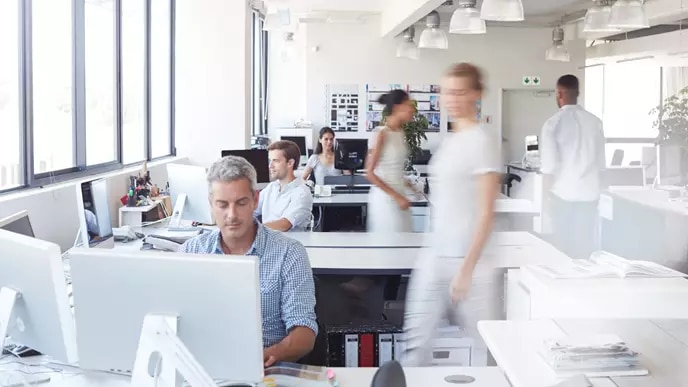The Evolution of The Office: How Workspaces Have Modernised

For many people, the office is their second home. The structure of our workplace plays a large role in life and impacts everything from our mood to our productivity. Now more than ever, employees place a strong emphasis on their wellbeing, stress levels and job satisfaction, which has shaped the evolution of an office over the years.
Office structures which only consider worker productivity and not employee satisfaction are quickly becoming a thing of the past and concepts such as working from home, hybrid offices and virtual offices are becoming the new norm.
The Cubicle Office
The cubicle designs was one of the first office structures which was first introduced in the 1960s as a method to maximise worker productivity by placing them in close proximity to one another. However, this structure did not take into account that people need more space, and being enclosed by walls in a small space can increase loneliness, stress and anxiety.
Although, it wasn't only employees which disliked the cubicle concept. The claustrophobic design also required a lot more furniture which costed business more money than they were willing to spend. The cubicle office also created more of a barrier between management and staff, which led to a lack of communication and collaboration.
Overall, it was soon realised that its design wasn't working for most businesses and its employees.
Open Floor-Plan Offices
In response to these issues, the open office plan was introduced in the 1990s. This type of office removes all partitions between employees in favour of a more collaborative environment. These typically incorporate long desks and plenty of communal spaces, such as breakout areas and coffee machines, which encourages staff to take breaks and socialise with one another.
As a byproduct of the open space, employees were able conduct work-related communication easier, which also benefited productivity.
However, there were some employees which found the new design to be quite disruptive as it made it difficult to concentrate. The open office also lacked privacy, which could make some workers feel exposed and uncomfortable, but this issue phased out as people became used to the concept.
Hybrid Offices
The hybrid office had become idealised since the advent of Covid-19.
When businesses slowly started to return to normal, many employees had become used to working from home and desired more flexibility.
To cater for this, businesses implemented hybrid arrangements where employees can split their work days between home and the office.
This structure is optimal for businesses as it allows them to save on office space and also gives employees the flexibility to work their own hours. The benefits of working from home are well documented and include decreased stress levels, improved productivity and less sick days.
Although some people might find it difficult to readjust to working in an office again, the hybrid model is a great compromise between the two arrangements.
Remote Work - Home Office
Another evolution of the office due to Covid, remote work has become one of the most popular trends in the workplace over the past few years. The home office arrangement allows employees to work from anywhere in the world, as long as they have an internet connection. Prior to Covid, remote working was an option, however it had become a global necessity during the depth of the pandemic.
The main benefit of remote work is that employees have more flexibility with their hours and can easily take time off for doctor's appointments or to care for a sick family member. Additionally, remote work can improve employee productivity as they can take their work with them wherever they go.
There are some drawbacks to remote work, such as feeling isolated from co-workers and not having the same level of team camaraderie. Additionally, working from home can also be distracting as there are many things which can pull employees away from their work
Despite these drawbacks, the pros of remote work far outweigh them and it is quickly becoming the preferred way for many employees to work.
Virtual Office
Originally created for small businesses to break into the global market or significantly reduce their costs whilst maintaining the essentials, virtual offices have also become a favoured option due to technological advances.
A virtual office is an online workspace that allows businesses to access all the same services and amenities they would find in a traditional office space, without actually having to rent or lease physical space. Virtual offices are often used by businesses that want to have a presence in multiple locations, or by businesses that are looking to save money on office space.
Virtual offices provide businesses with a credible addresses, receptionist, I.T. support and secretarial support. This type of an office has evolved from small businesses needing resources which would otherwise cost too much and create too many liabilities whilst still being in the early stage of their business lifecycle.
The Future of Offices
The future of offices is slowly moving away from the traditional work structures and embracing more flexible work arrangements. This is mainly due to the fact that many employees are now requesting more flexibility in their hours.
Businesses are now implementing hybrid office models, which allow employees to split their work day between home and the office. Additionally, remote work is becoming increasingly popular as it allows employees to work from anywhere in the world.
Based off this, the future of offices is likely to shift towards virtual offices, coworking spaces and hybrid arrangements.
Contact Us
If you’ve got any questions call us 1300 409 755 or fill in your information below and we’ll get back to you shortly.





